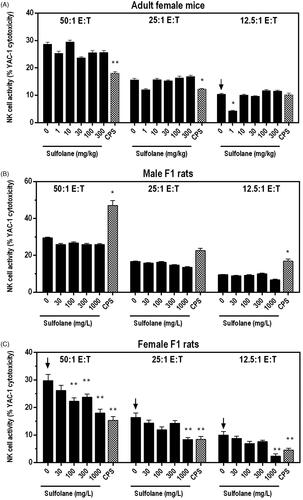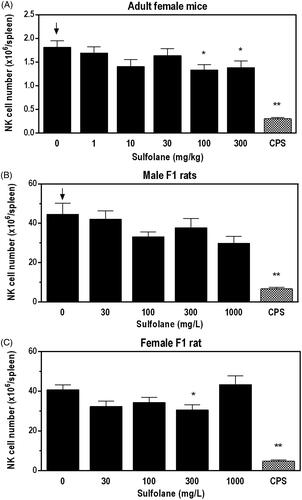Figures & data
Table 1. Study cohorts and endpoints assessed in sulfolane-treated adult female B6C3F1/N mice (n = 8/treatment group) and F1 Harlan Sprague Dawley rats (n = 12/sex/treatment group).
Table 2. Mean water consumption and sulfolane intake during the perinatal and post-weaning period in HSD rats (Cohort 1) exposed to sulfolane in drinking water.
Table 3. Organ weights in male and female F1 rats exposed developmentally to sulfolane.
Table 4. Select hematological parameters following daily gavage exposure to sulfolane in female mice.
Figure 1. NK cell activity following exposure of adult female B6C3F1/N mice and F1 rats to sulfolane. Cyclophosphamide (CPS) administered via IP intraperitoneal injection at 15 mg/kg (rat) or 50 mg/kg (mice). Arrows indicate significant decreasing trend with increasing sulfolane exposure (p < 0.01 for mice and p < 0.05 for rats). Result is significantly different from vehicle control group (*p < 0.05; **p < 0.01). E:T: effector:target ratio.

Figure 2. Splenic NK cell numbers following exposure of adult female B6C3F1/N mice and F1 HSD rats to sulfolane. Cyclophosphamide (CPS) administered via IP injection at 15 mg/kg (rat) or 50 mg/kg (mice). Arrows indicate a significant decreasing trend with increasing sulfolane exposure (p < 0.05). Result is significantly different from vehicle control group (*p < 0.05; **p < 0.01).

Table 5. Splenic immunophenotyping following gavage exposure to sulfolane in female B6C3F1/N mice.
Table 6. Splenic immunophenotypes following drinking water exposure to sulfolane in male and female F1 HSD rats.
